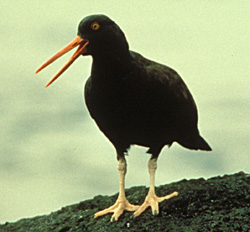|
Oystercatchers |

American Black Oystercatcher
(Haematopus bachmani)
|
|
Scientific classification |
| Kingdom: |
Animalia
|
| Phylum: |
Chordata
|
| Class: |
Aves
|
| Order: |
Charadriiformes
|
| Family: |
Haematopodidae
Bonaparte, 1838 |
| Genus: |
Haematopus
Linnaeus, 1758 |
|
| Species |
Magellanic Oystercatcher
H. leucopodus
Blackish Oystercatcher
H. ater
American Black Oystercatcher
H. bachmani
American Oystercatcher
H. palliatus
Canarian Black Oystercatcher †
H. meadewaldoi
African Black Oystercatcher
H. moquini
Eurasian Oystercatcher
H. ostralegus
Australian Pied Oystercatcher
H. longirostris
Chatham Island Oystercatcher
H. chathamensis
Variable Oystercatcher
H. unicolor
Sooty Oystercatcher
H. fuliginosus |
The Oystercatchers are a group of
waders; they form the
family Haematopodidae, which has a single
genus, Haematopus. They are large obvious and
noisy
plover-like
birds, with strong bills used for smashing or prising
open
molluscs.
In some species, the bill shape varies according to the
diet. Those birds with blade-like bill tips prise open or
smash mollusc shells, and those with pointed bill tips tend
to probe for
annelid worms.
They are found on coasts worldwide apart from the polar
regions. They are all-black, black and white or brown and
white in appearance.
Their
eggs are laid in a shallow scrape on shingle.
Oystercatcher eggs are grey and speckled, providing
camouflage against the grey rock background. They are
pointed at one end. Contrary to popular belief, the purpose
of this is not to provide space for the chick's long beaks
(their long beaks develop after hatching). The pointed shape
is thought to prevent the eggs from rolling down a steep
slope.
|
|
American Black Oystercatcher (Haematopus
bachmani)
|
American Oystercatcher (Haematopus
palliatus)
Image from 'Birds of America" J.J. Audubon
|
Oystercatchers chasing crabs, Galapagos
|
Oystercatchers nesting, Galapagos
|
Oystercatchers swapping places on nest,
Galapagos
|
Black Oystercatcher at the
Monterey Bay Aquarium
|
External links




